In recent years, artificial intelligence (AI) tools have revolutionized numerous industries, including education and training. Tools like ChatGPT, Synthesia, and course authoring software equipped with AI capabilities have made it possible to generate course content in record time. These tools promise to reduce the effort required for content creation, streamline instructional design, and lower production costs. However, while these advantages are appealing, it’s critical to understand that relying solely on AI tools to rapidly develop course content has significant limitations. Ignoring these limitations can compromise the quality, effectiveness, and learner experience of the courses created.
This article explores the key limitations of using AI tools for rapid course content development, providing a balanced perspective for educators and training professionals seeking to integrate AI into their workflows.
1. Lack of Contextual Understanding
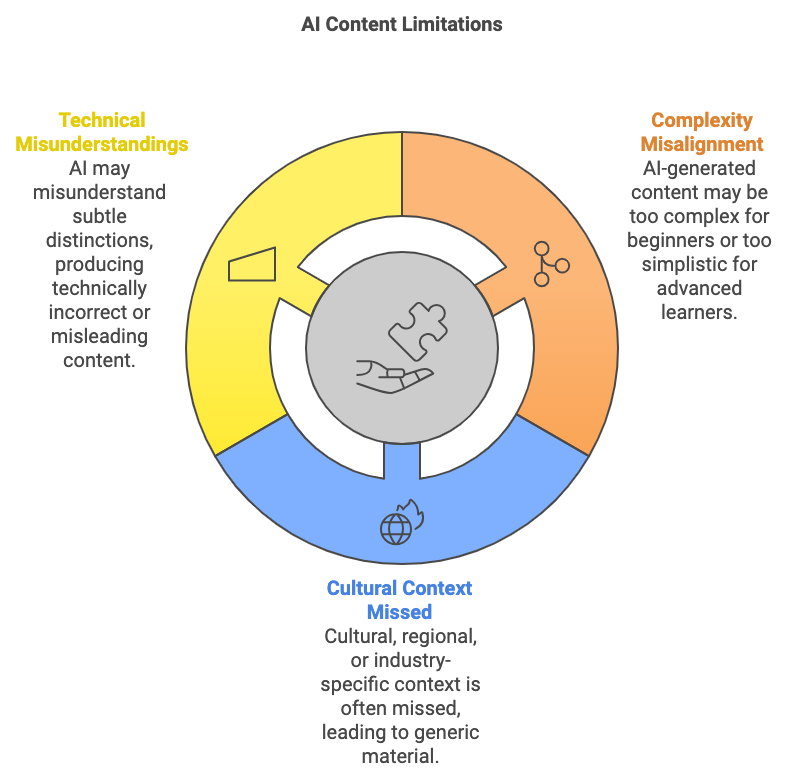
AI tools excel at processing large volumes of data and generating text based on patterns, but they lack true understanding of context. While they can create content that appears coherent, the nuances of a specific subject, target audience, or instructional goal may be misrepresented or oversimplified. For example:
- AI-generated content may use language that is too complex for beginners or too simplistic for advanced learners.
- Cultural, regional, or industry-specific context is often missed, leading to generic material that fails to resonate with the audience.
- AI may misunderstand subtle distinctions within a topic, producing content that is technically incorrect or misleading.
For highly specialized fields such as medical training, legal education, or advanced technical courses, this limitation becomes particularly problematic. Educators must manually verify and refine AI-generated content to ensure accuracy and relevance.
2. One-Size-Fits-All Approach

AI tools are generally designed to generate content for a broad audience, and they struggle to tailor material for specific learner needs. Effective instructional design involves customizing content based on factors such as:
- Learners’ prior knowledge and experience levels.
- Learning preferences (e.g., visual, auditory, or hands-on approaches).
- Accessibility requirements for learners with disabilities.
AI tools often fail to incorporate differentiated learning strategies, leaving educators to bridge the gap. For instance, an AI might produce text-heavy content that overlooks the needs of visual learners or those requiring alternative formats like screen-reader-compatible materials.
3. Overlooking Pedagogical Principles
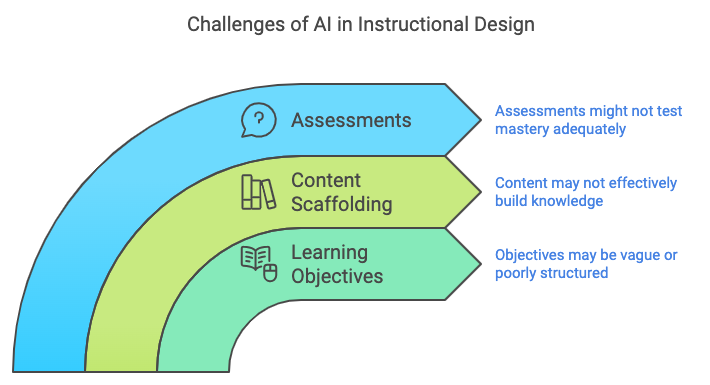
Instructional design is rooted in established pedagogical principles, such as Bloom’s taxonomy, ADDIE (Analyze, Design, Develop, Implement, Evaluate), and Gagné’s Nine Events of Instruction. AI tools lack an intrinsic understanding of these principles and cannot ensure that the generated content aligns with effective teaching practices. As a result:
- Learning objectives may be vague or improperly structured.
- Content may not scaffold knowledge effectively, leading to gaps in learners’ understanding.
- Assessments and activities might not adequately test learners’ mastery of the material.
AI-generated content often requires significant intervention from subject matter experts and instructional designers to integrate these principles into the course structure.
4. Limited Creativity and Innovation
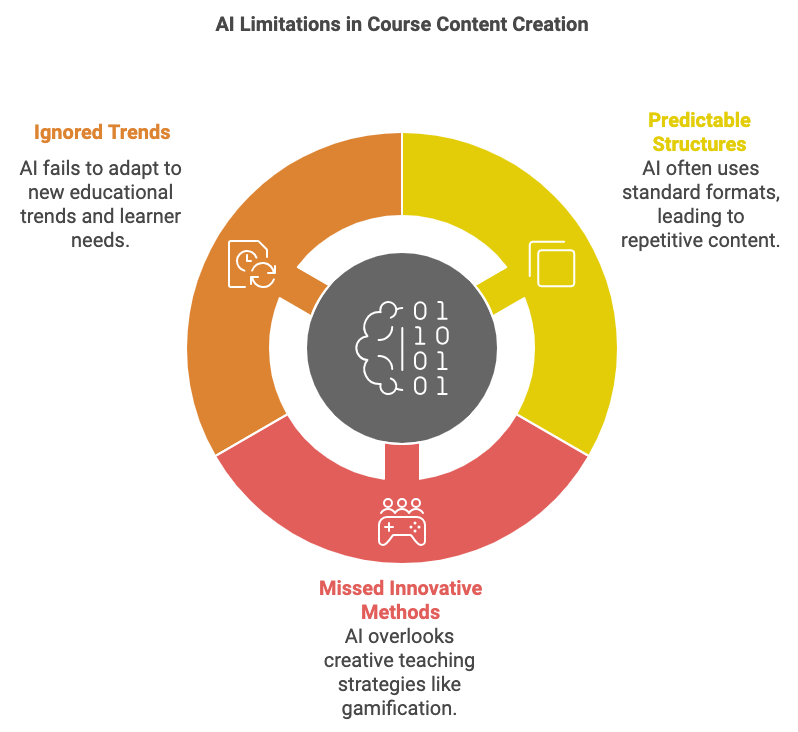
While AI can generate content based on existing patterns, it struggles with originality and creativity. Innovative course content often requires human insight to create engaging narratives, thought-provoking examples, and real-world applications. AI tools tend to:
- Rely on predictable structures and phrasing, which can lead to monotonous or uninspiring content.
- Miss opportunities to incorporate unique or unconventional teaching methods, such as gamification, storytelling, or interactive case studies.
- Fail to account for emerging trends or evolving learner expectations.
Creativity is essential for capturing learners’ attention and maintaining their engagement, and this is an area where AI tools currently fall short.
5. Ethical and Bias Concerns

AI systems are trained on large datasets, which may contain biases reflective of the content they have analyzed. When these biases are inadvertently embedded into course material, they can lead to ethical concerns and potentially harm learners. Examples include:
- Gender, racial, or cultural stereotypes being perpetuated in examples or scenarios.
- Unequal representation of diverse perspectives or voices.
- Promotion of outdated or inaccurate information due to reliance on biased training data.
Educators and training professionals must carefully review AI-generated content to identify and mitigate any biases, adding another layer of work to the process.
6. Challenges in Ensuring Accuracy and Reliability
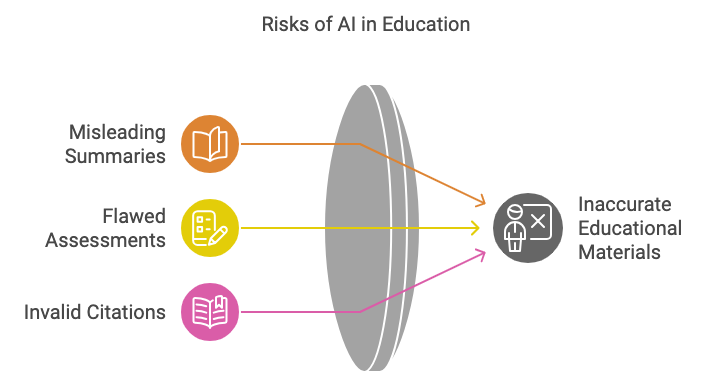
AI tools generate content based on probabilistic models, which means they sometimes “hallucinate” facts or present inaccurate information confidently. This can be especially problematic for educational materials, where factual accuracy is paramount. For example:
- AI might incorrectly summarize complex concepts or misrepresent key ideas.
- Generated quizzes or assessments may contain flawed questions or answers.
- References or citations may be fabricated or invalid.
Every piece of AI-generated content must be rigorously reviewed by subject matter experts to ensure it meets quality standards, which can offset the time savings promised by these tools.
7. Lack of Emotional Intelligence
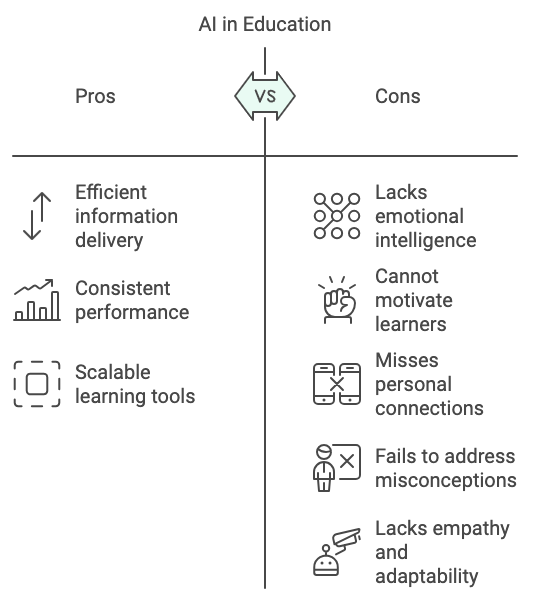
Teaching is not just about delivering information; it’s about fostering connections, motivating learners, and addressing their challenges. AI lacks emotional intelligence, which is critical for:
- Encouraging learners who may feel overwhelmed or disengaged.
- Anticipating and addressing potential learner misconceptions.
- Designing content that resonates on a personal or emotional level.
Human educators bring empathy and adaptability to the learning experience, qualities that AI cannot replicate.
8. Dependency Risks
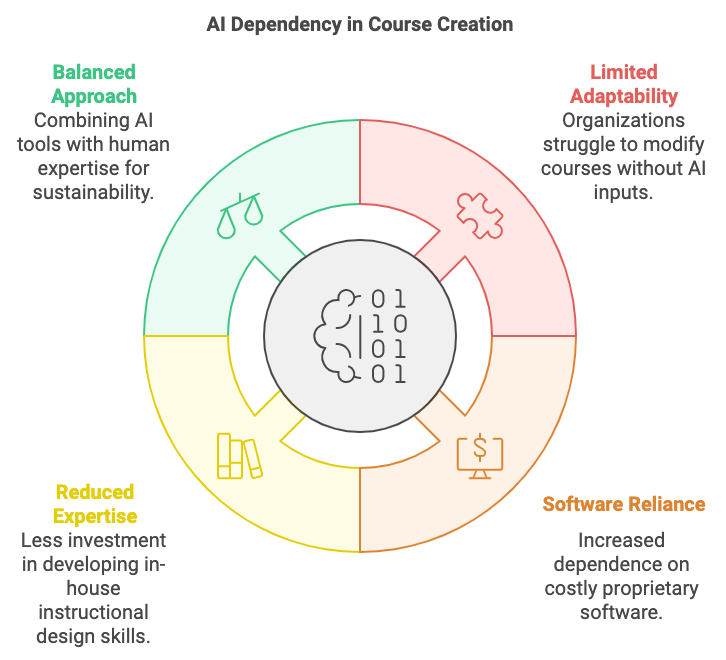
Relying heavily on AI tools for course creation can lead to dependency, making organizations vulnerable to issues such as:
- Limited ability to adapt or improve courses without AI-generated inputs.
- Increased reliance on proprietary software, which may have licensing or cost implications.
- Reduced investment in developing in-house instructional design expertise.
A balanced approach that combines AI tools with human expertise ensures sustainability and flexibility in course development.
9. Time Savings vs. Quality Trade-Off
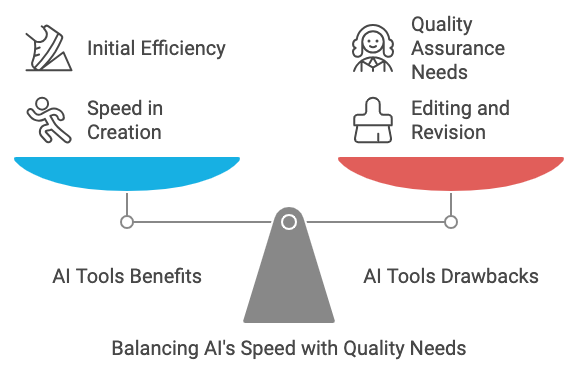
While AI tools can accelerate content generation, they often shift the workload rather than eliminate it. The time saved in initial content creation may be offset by the need for:
- Thorough editing and revision.
- Integration of multimedia elements like videos, animations, or interactive exercises.
- Alignment with institutional or organizational standards.
Rapidly produced courses that prioritize speed over quality can undermine learners’ trust in the material and harm the organization’s reputation.
10. Legal and Intellectual Property Issues
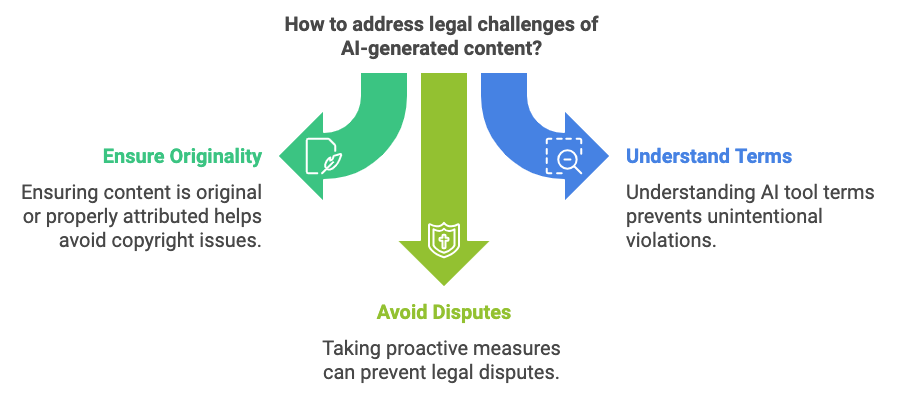
AI-generated content can raise legal questions regarding copyright and intellectual property. If an AI tool generates material based on copyrighted content in its training data, the resulting course material may unintentionally violate intellectual property laws. Organizations using AI tools must:
- Ensure that content is original or properly attributed.
- Understand the terms of use for the AI tools they employ.
- Take measures to avoid potential legal disputes.
These challenges require careful consideration, particularly for organizations operating in regulated industries.
Conclusion: A Balanced Approach Is Key
AI tools for course creation offer undeniable advantages, including speed, scalability, and automation. However, their limitations underscore the importance of maintaining a human-centered approach in instructional design. Educators and training professionals should view AI as a tool to enhance, not replace, their expertise. By combining AI-generated content with human oversight, creativity, and empathy, it is possible to create courses that are not only efficient to produce but also engaging, accurate, and impactful.
Ultimately, the goal should be to strike a balance—leveraging the strengths of AI while addressing its weaknesses—to ensure that learners receive high-quality, meaningful educational experiences.

